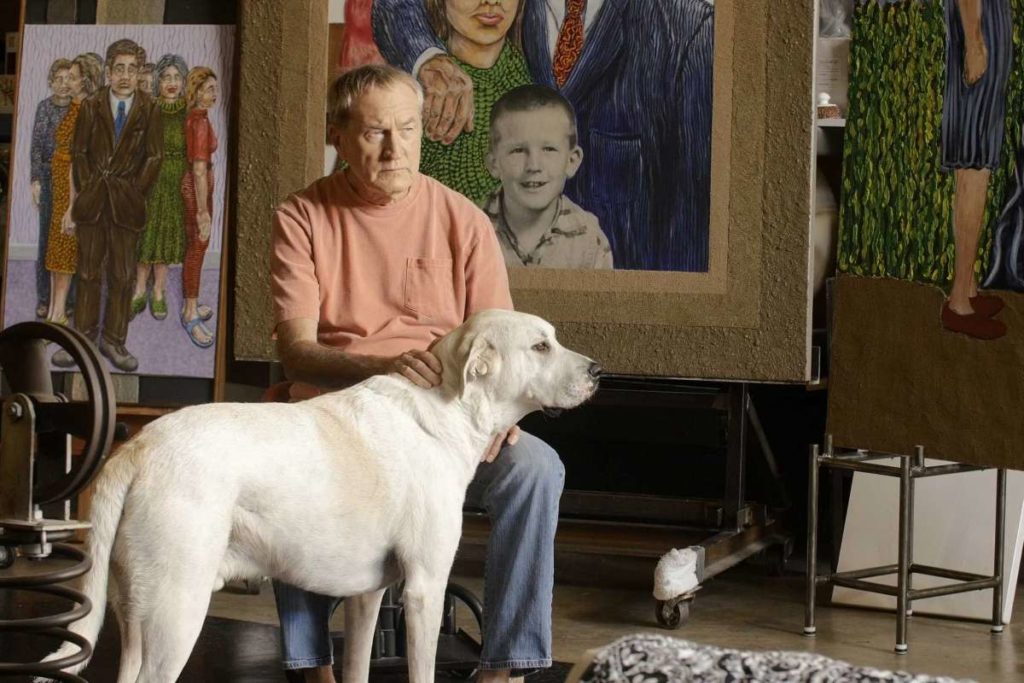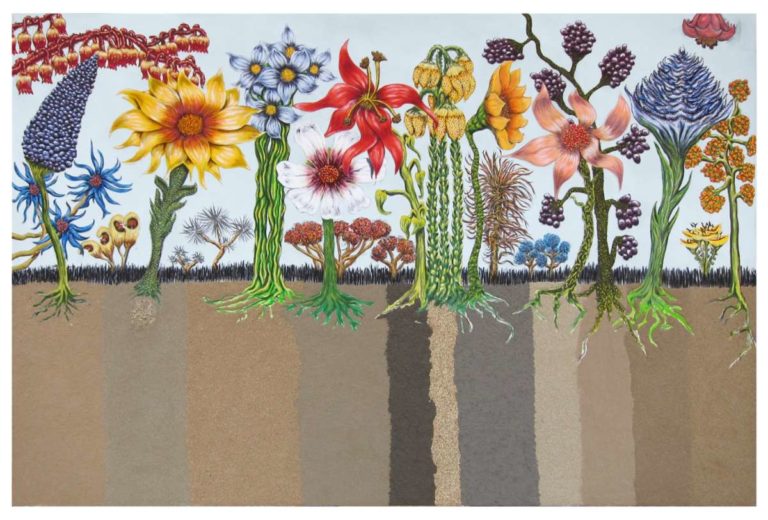Remains of his days
Artist Wayne Gilbert Ponders What To Do With Life's Work That Incorporates Cremation Ashes
Written By Molly Glentzer of the Houston Chronicle

Wayne Gilbert doesn’t mind admitting he has sold very few of the paintings he has made during the past 30 years. He assumes few people are comfortable living with what he calls their “yuck” factor: The iconoclastic Houston artist covers his canvases with unclaimed, cremated human remains that he mixes with a gel, sometimes adding paint pigments.
Gilbert says buyers have expressed interest in his work, but he’s loath to sell it, partly because he doesn’t know how to price it and also because he doesn’t want it to belong to anyone who might not take care of it in a respectful way.
But Gilbert, who turns 71 this month, has been thinking lately about posterity and what to do with the 40-by-50-foot climate-controlled trailer where he has stored his life’s work.
He recently commissioned director Wayne Slaten to tell his story in the documentary “Ash.” The 58-minute film premieres, along with Cressandra Thibodeaux’s 30-minute “Jesse Lott: Artist in Action,” Sunday during the Houston Cinema Arts Festival. Link on IMDB
Gilbert didn’t censor the numerous art-world figures who comment on his work and motives in the film – among them Station Museum founder Jim Harithas, Blaffer Art Museum director Toby Kamps, Contemporary Arts Museum Houston director Bill Arning and the especially eloquent “Engines of Our Ingenuity” creator John Lienhard.
Susan Aberth, an art historian at Bard College in New York, may be Gilbert’s most vocal champion. She believes his paintings exude psychic power. Others sound respectful but professionally conflicted about the work: Gilbert’s imagery is not particularly sophisticated, often incorporating textual or visual puns about death.
Harithas may nail it best, seeing Gilbert as an artist who found his own way and materials and continuous experiments. But Harithas also tempers his praise. “He is … a self-styled intellectual who thinks he knows more than he does,” he says in the film. “Where he knows a lot is in his art, and that’s where he communicates to me, more than with some of his theories we don’t agree on.”
The film doesn’t cover Gilbert’s full story.
A native Houstonian, he grew up in Houston’s East End and lost his father before he was 9. His mother worked downtown as a punch-card operator.
He’s been controversial pretty much since the day he decided to become an artist. To help him sober up from drug and alcohol addictions in 1977, his wife, Beverly Gilbert, persuaded him to enroll with her in a class at the Museum District home of artist Chester Snowden.
Gilbert began drawing, and by 1984, he had a painting degree from the University of Houston. His teachers included Gael Stack and Richard Stout, but he didn’t identify with the fine-art-focused talents that emerged from the school.
“I came from a practical, oil-field sales background,” he says.
Nor did he need to make a living with his art. The Gilberts established a photo-retouching company in the late 1970s that today, as DigitalImaging Group, has 27 employees and national clients. The business also enables him to support other artists, most recently through his G Spot Contemporary Gallery in the Heights.

“Rites of Spring” is among the paintings Houston artist Wayne Gilbert has created with unclaimed, cremated human remains.
As an artist, Gilbert was always hell-bent on provocation. During his first six or seven years as a painter, he made canvases he describes as “Absurd Expressionism,” focused on humanity at its ugliest, inspired by subjects such as the Jonestown Massacre.
He staged shows with other underground artists that often involved S&M performances and nudity. Gilbert’s first art gallery, 101 Space, closed with a “human piñata” performance in which a bubble-wrapped cowboy hung from the ceiling to be attacked by a bull.
“We were outsiders,” Gilbert says. “None of the museum people or galleries cared or were interested.”
Gilbert insists he’s exploring the philosophical nature of art: What is it that we respond to that can make a canvas something priceless, something that drives financial markets, when it is essentially nothing more than an object to hang on a wall?
When the idea for painting with cremated remains finally hit him, “It sounded almost like a deep breath of fresh air,” he says. “It just seemed like the greatest way in the world to communicate the message that I intended: How weird is all of this art-world stuff?”
Finding a source for his material took persistence. Eventually he made his way to James Claire, the owner of a funeral home in southwest Houston who gave him access to a closet full of unclaimed remains.
“I don’t give up easily. I’m just not the kind of guy that quits much of anything,” Gilbert says.
But from the moment he placed his first boxed collaborator, if you will, on the car seat beside him to drive her back to his studio, he seems to have felt genuine respect for the remains with which he has been entrusted.
He loves watching viewers’ reactions when they realize what they’re seeing in his paintings. Invariably, heads turn.
“I understand sometimes just how radical this stuff is,” Gilbert says, “but it’s also communication, talking about this stuff.”
He motions to a pure white canvas above the desk at G Spot. Unlike his other works, it has a small box affixed to its center.
“That’s intense. That’s big people stuff there,” he said. “That’s a little boy that was born, died and was cremated and left behind in a closet.”
Gilbert has never seen his work as “funerary” art, generally shunning commissions from potential buyers who would like to have their own loved ones’ remains incorporated into paintings.
And though he has shown his work in at least 20 countries, Gilbert feels frustrated that he’s been ignored by the mainstream art world. He cites his “Stars and Stripes Forever” painting, noting that Jasper Johns and “a whole litany of artists” have made famous works based on American-flag imagery, yet he can’t get his piece – which contains the remains of three actual Americans – on anyone’s radar.
“I’ve obviously got a big enough ego that I would have liked to have been acknowledged,” he says.
Though he no longer harbors any fantasies about fame, Gilbert still wants all of his paintings – and the people contained within them – to be handled properly when he’s gone.
“This sounds a little weird, but one of the things I might do, because I can afford it,” he said, “I might find a piece of land that nobody knows about, and find a backhoe big enough to dig a hole big enough to put that 40-by-50-foot trailer in there and just cover it with earth, put a small plaque on it and get on with it.”
At least with this issue, he is not alone. Plenty of older artists, successful and not-so-successful, are burdened with unsold works.
“But this stuff is a little bit different because it has this significance of being people,” Gilbert says. “So it’s a conundrum.”
Molly Glentzer, a staff arts critic since 1998, writes mostly about dance and visual arts but can go anywhere a good story leads. Through covering public art in parks, she developed a beat focused on Houston’s emergence as one of the nation’s leading “green renaissance” cities.
During about 30 years as a journalist Molly has also written for periodicals, including Texas Monthly, Saveur, Food & Wine, Dance Magazine and Dance International. She collaborated with her husband, photographer Don Glentzer, to create “Pink Ladies & Crimson Gents: Portraits and Legends of 50 Roses” (2008, Clarkson Potter), a book about the human culture behind rose horticulture. This explains the occasional gardening story byline and her broken fingernails.
A Texas native, Molly grew up in Houston and has lived not too far away in the bucolic town of Brenham since 2012.